Abstract
Different terminals, with their unique combinations of liner services, yard layouts and equipment configurations, may find that different yard planning strategies work better for their scenarios. While an optimum yard plan can be found for each yard planning strategy, it is interesting to know which strategy gives the best plan. In designing an IT-based search engine to discover the best yard planning strategy and/or scenario, having a generic specification and solver is important, so that the whole solution space could be represented and searched. We design a generic problem specification with parameterised scenarios and yard planning strategies, and formulate a generic mathematical model that solves for the optimum weekly yard plan template for that given problem. A good run time of this generic model is extremely important as the model will be executed hundreds of times in the search engine. Experiments are conducted with the model. An interesting discovery is that re-modelling a set of integer variables into multiple binary variables improve the run time tremendously, and in some cases, outperform the relaxed original model. We also find that the strategy which allows sharing of yard space between services yield better utilization for yard space and rail mounted gantry handling capacity.
Similar content being viewed by others
References
Bruzzone A, Signorile R (1998) Simulation and genetic algorithms for ship planning and shipyard layout. Simulation 71(2): 74–83
Chen T (1999) Yard operations in the container terminal—a study in the “unproductive moves”. Marit Policy Manage 26(1): 27–38
Cheung RK, Li CL, Lin W (2002) Interblock crane deployment in container terminals. Transp Sci Informs 36(1): 79–93
de Castilho B, Daganzo CF (1993) Handling strategies for import containers at marine terminals. Transp Res B 27B: 151–166
Dekker R, Voogd P, van Asperen E (2006) Advanced methods for container stacking. OR Spectr 26(4): 563–586
Huang WC, Chu CY (2004) A selection model for in-terminal container handling systems. J Marit Sci Technol 12(3): 159–170
Kim KH (1997) Evaluation of the number of rehandles in container yards. Comput Ind Eng 32(4): 701–711
Kim KH, Bae JW (1998) Re-marshaling export containers in port container terminals. Comput Ind Eng 35(3-4): 655–658
Kim KY, Kim KH (1997) A routing algorithm for a single transfer crane to load export containers onto a containership. Comput Ind Eng 33(3-4): 673–676
Kim KH, Kim HB (1999) Segregating space allocation models for container inventories in port container terminals. Int J Prod Econ 59: 415–423
Kim KH, Kim HB (2002) The optimal sizing of the storage space and handling facilities for import containers. Transp Res B 36B: 821–835
Kim KH, Park KT (2003) A note on a dynamic space-allocation method for outbound containers. Eur J Oper Res 148: 92–101
Kim KH, Park YM, Ryu KR (2000) Deriving decision rules to locate export containers in container terminal. Eur J Oper Res 124: 89–101
Kim KH, Lee KM, Hwang H (2003) Sequencing delivery and receiving operations for yard cranes in port container terminals. Int J Prod Econ 84: 283–292
Lee LH, Chew EP, Tan KC, Han Y (2006) An optimization model for storage yard management in transshipment hubs. OR Spectr 28(4): 539–561
Levinson M (2006) The box—how the shipping container made the world smaller and the world economy bigger. Princeton University Press, New Jersey
Linn RJ, Zhang CQ (2003) A heuritic for dynamic yard crane deployment in a container terminal. IEE Trans 35: 161–174
Murty KG, Wan YW, Liu J, Tseng MM, Leung E, Chiu HWC, Lai KK (2005) Hongkong international terminal gains elastic capacity using a data-intensive decision support system. Interfaces 35(1): 61–75
Narasimhan A, Palekar US (2002) Analysis and algorithms for the transtainer routing problem in container port operations. Transp Sci 36(1): 63–78
Ng W (2005) Crane scheduling in container yards with inter-crane interference. Eur J Oper Res 164(1): 64–78
Petering ME, Murty KG (2006) Simulation analysis of algorithms for container storage and yard crane scheduling at a container terminal. In: Proceedings of the second international intelligent logistics systems conference, Brisbane, Australia, pp 19.1–19.15
Saanen YA, Dekker R (2007a) Intelligent stacking as way out of congested yards? part 1. Port Technol Int 31: 87–92
Saanen YA, Dekker R (2007b) Intelligent stacking as way out of congested yards? part 2. Port Technol Int 32: 80–85
Stahlbock R, Voß S (2008) Operations research at container terminal: a literature update. OR Spectr 30: 1–52
Taleb-Ibrahimi M, de Castilho B, Daganzo CF (1993) Storage space vs handling work in container terminals. Transp Res B 27: 13–32
Vis IF, de Koster R (2003) Transhipment of containers at a container terminals: an overview. Eur J Oper Res 147: 1–16
Zhang C, Liu J, Wan YW, Murty KG, Linn R (2003) Storage space allocation in container terminals. Transp Res B 37B: 883–903
Author information
Authors and Affiliations
Corresponding author
Rights and permissions
About this article
Cite this article
Ku, L.P., Lee, L.H., Chew, E.P. et al. An optimisation framework for yard planning in a container terminal: case with automated rail-mounted gantry cranes. OR Spectrum 32, 519–541 (2010). https://doi.org/10.1007/s00291-010-0200-9
Published:
Issue Date:
DOI: https://doi.org/10.1007/s00291-010-0200-9




